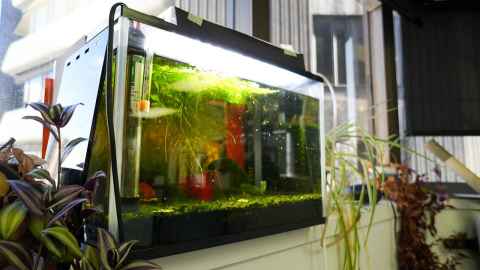My Space: the life aquatic
2 September 2024
As part of our regular My Space series exploring fascinating workspaces around the University, UniNews visits Auckland Bioengineering Institute's Biomimetics Lab.

A submarine shaped like a fish, a clothes rack stacked with wetsuits, fish tanks filled with creatures – it’s not hard to pick a theme at the Biomimetics Lab at the Auckland Bioengineering Institute (ABI).
The world of biomimetics is all about creating technology inspired by nature, and the lab’s engineers especially look to the underwater world in their work engineering soft sensors and robots. Unlike conventional rigid robots, these are machines that are soft and flexible – “things that can do all sorts of weird things like an octopus”, says leader of the Biomimetics Lab, Professor Iain Anderson.
It’s no surprise then, that a large tank teeming with all kinds of fish occupies a central position in the lab’s shared space. Each new PhD student gets to add a fish (or two) to the community, explains Dr Massi Hesam, a research fellow who’s working on giving robots a sense of touch.
Most people in this lab have a diving licence, either by requirement - or by peer pressure.

It not only creates a kind of parallel fish world inside the lab, but it means that as people move on, they also leave something of themselves behind. Some students, like PhD candidate Cheng-Huan Lu, also breed fish to add to the tank; he’s bred a healthy population of angel fish and is currently cultivating a community of East African cichlids.
The sea not only provides inspiration, but a destination for some of the technology the lab is developing. Postdoctoral fellow Dr Derek Orbaugh is leading work on underwater wearables – smart wetsuits that can monitor divers’ movements and physiological states, and gloves with sensors that allow divers to communicate in murky underwater conditions.
Which helps explain that rack of wetsuits. “One of the nice things about working on this technology is you get to go diving every now and then,” says Derek.
“Most people in this lab have a diving licence,” explains PhD student Antony Tang, “either by requirement – or by peer pressure.” Some have trained as advanced or rescue divers in the name of testing the technology and others specialise in underwater photography to capture the results.
And in times past, members of the lab have literally crawled beneath the skin of a fish in the name of science – which brings us to the submarine.
Called The Taniwha, the submarine now sits on the ground floor of the ABI building on Symonds Street, a reminder of the glory days when it took out top prize in the European international human-propelled submarine races of 2016.
Submarine pilot Dr Chris Walker, a Biomimetics Lab PhD student at the time, piloted the vessel, peddling the fish-shaped vessel while submerged inside.
One of the sub’s competitive advantages, says Iain, was its rear section that could bend like a fish, allowing it to be steered without a rudder.
Like a school of fish, members of the lab also like to stick together.
Alongside the fish tank, central features of their shared space are a couple of couches and a big communal table. They gather here every day to prepare and eat lunch together, pooling their resources to create a meal, and play chess.
“We feel like we’re part of a family here,” says Massi. “We really enjoy ourselves and enjoy each other’s company.”
Caitlin Sykes
This article first appeared in the September 2024 issue of UniNews.